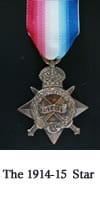The Great War
When the First World War began in 1914, the 8th Hussars were stationed at Ambala, 125 miles north of Delhi in India. The Regiment was mobilized on 31 August and left India at Bombay in two halves in October 1914.
The Regiment served as part of the Ambala Cavalry Brigade, 1st Indian Cavalry Division and arrived at Marseilles, France in November.
By the time they had landed in France, a system of trenches was firmly established. This meant that the regiment couldn’t initially be used in a mounted role but often went into the trenches dismounted or provided digging parties.
Givenchy, 20-21 December 1914
The 8th Hussar’s first experience of trench warfare was at Gorre, France on 9 December 1914.
From there they were sent to stand by in the reserve of the Indian Corps during the crucial defence at Givenchy on 20-21 December 1914.
On 15 September 1915, the Ambala Brigade was transferred to the 2nd Indian Cavalry Division which was renamed as the 5th Cavalry Division in November 1916.
In February 1918, the 5th Cavalry Division was disbanded and the 8th Hussars joined the 9th Cavalry Brigade.
The Battles of the Somme, 1916
The Regiment was involved in many of these repeated attempts to break the German lines in the Somme valley, most notably the assault on the Bazentin Ridge from 14-17 July and the taking of the villages of Flers and Courcelette between 15-22 September, the first-ever use of tanks.
The Regiment returned to the Somme area in March 1917 to clear the small pockets of machine guns left by the retreating Germans.
The Action at Villers Faucon, 27 March 1917

One of the two captured Maxim machine guns
At this stage of the war, the Germans had voluntarily retired to the Hindenburg Line, with the British driving back small German rear guards one of which held the village of Villers Faucon.
Under Major Van der Byl “B” and “D” Squadrons were ordered to attack with artillery and two armoured cars in support. The cars were stopped by a huge crater and then disabled by German armour-piercing bullets.
“B” Squadron charged two copes to the west of the village and then dismounted to give covering fire for “D” Squadron who circled east and attacked from the south.
Such was the speed of the attack that the German officer captured in the village said that he had been unable to alter his plans to counter it.
The two Squadrons captured sixteen Germans and two machine guns, the latter of which have remained outside the Regimental Guardroom since that battle.
Why not read a full detailed account of this action here
The Battle of Cambrai, 20 November – 3 December 1917
The 3rd King’s Own Hussars, the 4th Queen’s Own Hussars and the 8th King’s Royal Irish Hussars were all involved in this massive attack on the German lines towards the end of 1917.
For the first time 400 tanks were used as the main thrust, backed up by 6 Infantry Divisions, 3 Cavalry Divisions and over 1000 guns, and in the first day, a salient 5 miles deep was forced into the German Line.
The cavalry as usual was waiting for their chance to exploit any gap in the line, but there were not enough reserves to reinforce the bridgehead and a strong German counter-attack soon retook all the ground they had lost.
At this stage of the battle, the 3rd and the 4th were both sent into the line as dismounted troops at Boulon Wood to stem the withdrawal.
The Battles of the Somme, 1918
The Battles of the Somme from 21 March to 5 April 1918 marked the last desperate attempt by the Germans to break through the British line protecting the Channel Ports.
The 8th King’s Royal Irish Hussars were mounted through most of these battles and were employed in plugging the line wherever it was weakest.
They fought at St Quentin from 21-23 March, Bapaume from 24-25 March and were on the Rosieres Ridge from 26-27 March.
Later in the year when the tide had turned and the Allies were on the advance, the Regiment was involved in the last Battle of the Somme at Albert from 12-13 August 1918.
On 11 November, at Maffles, the Regiment heard that the armistice had been signed. They had lost 105 killed and many, many more wounded in the previous four years.
In Remembrance
A nominal roll of the officers of the 8th Hussars who died, along with a summary of the war diary entry/event, during The Great War 1914-18 is now available.
You can view this document here.
Battle Honours
The 8th King’s Royal Irish Hussars were awarded a total of 15 battle honours during this period.
Why not discover the action behind each one:
- Givenchy 1914
- Somme 1916, ’18
- Bazentin
- Flers-Courcelette
- Cambrai 1917, ’18
- St Quentin
- Bapaume 1918
- Rosieres 1918
- Amiens
- Albert 1918
- Hindenburg Line
- St Quentin Canal
- Beaurevoir
- Pursuit to Mons
- France and Flanders 1914-18
The Great War 1914-18 Medals




The 1914 Star was awarded to personnel who served in France and Belgium between 5 August and 22 November 1914.
1914-15 Star
The 1914-15 Star was awarded to personnel who saw service in any theatre of war between 5 August 1914 and 31 December 1915, other than those who had already qualified for the 1914 Star.
British War Medal 1914-20
The British War Medal 1914-20 was awarded to personnel in recognition of the successful conclusion of World War 1. It was later extended until 1920 to cover mine-clearing services and operations in North and South Russia, the eastern Baltic, Siberia, the Black Sea and Caspian.
The Victory Medal 1914-19 was awarded to all personnel who received the 1914 or the 1914-15 Stars. It is often referred to as the Allied War Medal.

